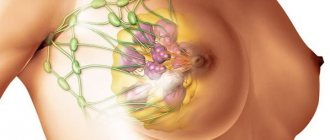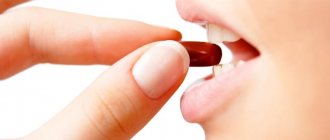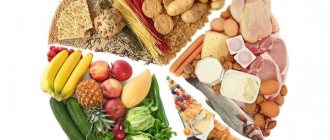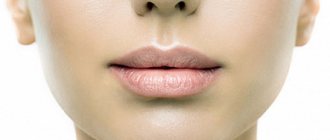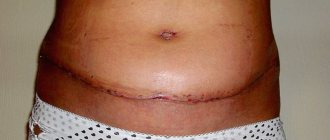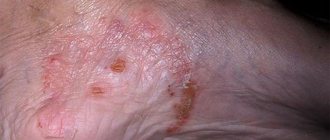The mammary glands in boys and girls are identical before puberty. At the age of 12-13, the male body begins to synthesize the hormone testosterone, which should be used to build a male body and form secondary sexual characteristics. Where then does enlarged breasts come from - gynecomastia in adolescents?
The fact is that many boys enter adolescence overweight. Malnutrition - lack of a full breakfast and frequent consumption of fatty and sweet foods leads to excess deposition of fatty tissue in the hips, lower back, abdomen and chest. This is also facilitated by the refusal of sports activities and a sedentary lifestyle. As soon as puberty occurs, the male hormone testosterone can be converted in excess into the female sex hormone estradiol, which forms breasts in such a teenager according to the female type and develops gynecomastia.
There is another option - physiological gynecomastia, associated with a sharp increase in testosterone levels, which goes away on its own in adolescents within a short time after its onset.
What causes breasts to grow?
Female mammary glands consist of glandular and adipose tissue, so their growth directly depends on the dynamics of development and structure of these components. With a predominance of adipose tissue, breast parameters will strongly correlate with body weight, and with a large number of glandular structures, their volume will be strongly influenced by the level of estrogen.
Breast growth largely depends on:
- Genetic background.
- Hormonal background.
- Body mass index. An additional 7-10 kg of weight can increase your breast size by 1 size.
- Development of the blood supply system in the thoracic area.
- General restorative procedures that increase blood flow to the surface of the chest: contrast water procedures, breast masks, regular intimacy and others.
The volume and shape of the breasts are significantly influenced by pregnancy and breastfeeding. Moreover, the size of the mammary glands after pregnancy can become both smaller and larger than the original ones.
Prognosis and complications
Gynecomastia can be complicated by inflammation - bacteria enter the gland through ducts or microcracks in the nipples. In this case, mastitis develops, requiring appropriate therapy.
Experts say that 10% of all cases of persistent gynecomastia can lead to the development of a tumor, so children with the fibrous stage of the pathology are recommended to undergo plastic surgery, which is not only aesthetic, but also medically preventive.
Gynecomastia in young men can lead to certain inconveniences, cause the development of complexes and depressive disorders, and significantly reduce the quality of life.
The prognosis of treatment depends on the form of pathology and the original disease. Drug-induced gynecomastia has the most favorable prognosis, but those caused by hereditary diseases are much more difficult to treat. The stage of fibrosis of the glands makes conservative therapy ineffective, which forces one to resort to surgical methods.
How can you tell if your baby's breasts are growing?
Breast growth in girls is accompanied by a number of signs that parents should pay attention to. The mother’s task is to explain to the child the naturalness of these processes and remove fears associated with unusual sensations. Breast growth begins at the milk line, a thin strip located below the nipples. It also forms in boys, but in them the line completely disappears during puberty.
The first signs of the beginning growth of a girl’s breasts are:
- Slight redness around the areola.
- Swelling of the milk line below the nipple.
- Pain in the chest area, especially when pressed.
- Increased amount of fatty tissue around the nipples.
Harbingers of breast growth are also signs of additional doses of estrogen entering the blood: increased sweating under the arms, rashes on the face, increased oily skin. A girl's breasts may begin to grow unnoticed. In such cases, its increased size will be a surprise to everyone.
Question to the expert
What should breasts look like at 15 years old? My breasts began to grow at the age of 12, and when I got my period at 13, my breasts practically stopped growing. Alina, 15 years old.
If your menstrual cycle is stable and you do not have any other problems associated with puberty, then stopping breast growth may be due to the individual characteristics of your body. By the age of 15, the breasts already take on an individual shape; there are no clear criteria for its size. If you are very worried, consult an endocrinologist.
Diagnostic methods
With the problem of enlarged glands, concerned parents most often come for a consultation with a pediatrician. The doctor will definitely refer them to an endocrinologist.
When examining the patient, the specialist first determines whether false or true gynecomastia occurs. The early age of a child - from two to 12 years - allows one to suspect a pathological form. The doctor must find out whether there are symptoms of underdevelopment of the gonads and accompanying signs characteristic of hereditary syndromes. Since true hyperplasia in boys after one year is uncommon, one might think about a serious endocrine disorder or a hormone-producing tumor.
Laboratory tests used:
- blood test for hormone levels (in dynamics) - testosterone, estradiol, gonadotropins, thyroid hormones,
- biochemical blood test, which pays attention to creatinine, liver enzymes,
- If genetic abnormalities are suspected, karyotyping is performed - a study of the child’s chromosome set.
Instrumental methods include:
- Ultrasound of the mammary glands and testicles,
- computed tomography of the adrenal glands,
- brain MRI,
- mammography (examination of the mammary glands).
Why do breasts grow slowly?
Slow breast enlargement is rarely caused by diseases or factors that a girl can influence. The growth rate of glandular and adipose tissue depends mainly on the level of estradiol and progesterone in the blood. They determine the intensity of the formation of new mammary ducts and the proliferation of their cells.
Estrogen levels, in turn, can decrease due to the following factors:
- Improper functioning of the pituitary gland.
- Thyroid diseases.
- Poor nutrition.
- Stressful situations.
- Lack of physical activity.
- Inflammation of the ovaries.
- Hormonal disorders after abortion.
- Taking hormonal drugs.
With small breast volumes in mothers and grandmothers, you should not hope for a size 3 daughter with a normal weight, because genetics plays an important role in the development of secondary sexual characteristics. If your breasts are not growing, then you can ask what foods you should eat to stimulate their growth.
If slow breast development greatly worries a girl, then you can consult a doctor to rule out serious pathologies that may limit the development of breast tissue. Self-administration of hormonal drugs before the age of 18 to accelerate breast growth is unacceptable, as it can lead to permanent disorders of the endocrine system.
Question to the expert
Please tell me what breasts should be like at 11 years old? My daughter will have almost no breasts when she grows up?
The absence of pronounced breasts in an 11-year-old girl is a variant of the norm. Wait a little and it will definitely grow.
Treatment of gynecomastia
Since hyperplasia of the mammary glands can accompany various pathologies, treatment is aimed at eliminating the cause of the increased content of estrogen in the child’s body. Physiological processes in children and adolescents do not require medical intervention. Parents are advised to observe and re-consult a doctor in case of long-term persistent gynecomastia.
The general principle of treating pathological gynecomastia is to reduce the level of female steroids. Along with medications, physiotherapy is used, it is advised to adjust nutrition, harden and play sports - swimming, outdoor sports games. Daily walks in the fresh air and jogging are beneficial.
Medicines
To treat idiopathic (with an unknown cause) gynecomastia in adolescents that persists longer than 3 years, antiestrogens (Tamoxifen) and aromatase activity blockers (Testolactone) are used.
Pathological proliferation of glandular tissue is treated taking into account its shape:
- For hyperprolactinemia, Bromocriptine or its substitutes are prescribed.
- With normal prolactin levels and sufficient testosterone production, adolescents are prescribed: aromatase inhibitors - Thiamine chloride,
- antiestrogens - Tamoxifen, Danazol, Clomiphene,
- Aevit and vitamin B1.
- amino acids - Glycine, Piracetam, glutamic acid,
The treatment of normopubertal gynecomastia is most effective; the hypopubertal form is the most difficult to cure. The effectiveness of therapy increases if it is started before 15 years of age.
Photo gallery: drugs for the treatment of gynecomastia
Bromocriptine is prescribed for gynecomastia caused by hyperprolactinemic syndrome
Tamoxifen is an anti-estrogenic drug and is prescribed for gynecomastia caused by high estrogen levels in adolescents.
Aevit is a combination drug prescribed for metabolic and hormonal disorders
Andriol is prescribed to adolescents with a hypopubertal form of gynecomastia caused by testosterone deficiency
Halidor is a drug that enhances the androgenic effect of testosterone preparations
Vitamin B6 (pyridoxine) is prescribed for fiminipubertal gynecomastia to regulate metabolic processes
Glycine is an amino acid prescribed to improve brain metabolism
Actovegin is a drug that affects metabolic processes in the brain and is prescribed for gynecomastia associated with dysfunction of the hypothalamic-pituitary system.
Teslac is a drug that inhibits aromatase, an enzyme that affects the conversion of testosterone to estrogens.
Vitamin B1 (thiamine) has the ability to inhibit the conversion of testosterone to estrogens
Physiotherapy
To reduce the secretion of prolactin, pubertal gynecomastia is treated using transorbital electrophoresis with gamma-hydroxybutyric acid; electrophoresis with potassium iodide (also transorbital) is used to influence the pituitary gland; bitemporal inductothermy is the use of a high-frequency magnetic field.
To treat false and true forms in combination with obesity, balneo- and hydrotherapy is used - carbon dioxide, hydrogen sulfide, iodine-bromine baths, mud therapy - mud applications on the collar area, the area of projection of the adrenal glands.
Folk remedies
Pathological enlargement of the mammary glands cannot be cured with folk remedies. Such methods can be used as an addition to traditional ones.
It is quite possible to use herbal medicine for physiological gynecomastia in adolescents, but you should first consult with your doctor. In this case, you need to select herbs with a general strengthening, normalizing metabolic processes, sedative and anti-inflammatory effect.
Thyme decoction is used as a soothing, anti-inflammatory agent:
- Dry raw materials (2 tablespoons) pour 600 ml of water, bring to a boil and simmer over low heat for 7 minutes.
- Cool and strain.
- Take 1/3 cup three times a day 20 minutes before meals.
Strengthening herbal mixture with ginseng:
- Take licorice, ginseng and eleutherococcus roots in equal parts, add the same amount of raspberry leaves, mix.
- Take a tablespoon of raw materials and pour 400 ml of boiling water.
- Leave in a thermos for at least 2 hours.
- Strain and take 2 tablespoons 4 times a day before meals.
Lovage decoction to normalize metabolism and hormonal levels:
- Dry raw materials (1 large spoon of crushed roots) should be poured with a glass of water and boiled under the lid for 20 minutes.
- Cool, strain, add boiled water to the original volume.
- Take a tablespoon 20 minutes before meals three times a day.
Nutrition correction
Dietary nutrition is especially important in mixed forms of pathology. It is impossible to get rid of mammary gland hyperplasia against the background of hormonal disorders by changing eating habits. But a balanced diet for any type of gynecomastia will definitely be beneficial.
If the glands of newborns become engorged, you should not give up breastfeeding and switch the baby to formula.
The diet of an older child should consist of an optimal amount of protein products (meat, dairy products, eggs), fresh fruits and vegetables, vegetable side dishes, and a variety of cereals. The child should receive a sufficient amount of fresh water, juices, and compotes. It is necessary to exclude fast food, sweet soda, foods with food additives and excessive amounts of sweets (cakes, pastries, fatty desserts). The baby's diet should be varied, fortified and as natural as possible.
The diet of adolescents can be further enriched with foods rich in zinc:
- meat (veal, rabbit, turkey),
- beef liver,
- citrus fruits,
- seafood,
- dates, figs,
- brown rice,
- wheat bran,
- nuts and mushrooms.
Green tea, rosehip drink, fruit drinks are useful.
Surgical intervention
A pronounced enlargement of the mammary glands, especially at the stage of fibrosis, practically does not respond to conservative therapy, so it is necessary to resort to surgery - removal of glandular tissue.
New techniques make it possible to avoid the consequences of surgical intervention in the form of rough keloid scars on the chest. Removal of glandular tissue is carried out through incisions made as close as possible to the areolas (subareolar access) or in the armpit area.
The recovery period does not take much time. After surgery, drains are placed and removed the next morning. In the next 2–3 days, elastic bandaging and wearing compression garments for 1–1.5 months are recommended to shrink the skin and form the correct muscle contour. Sutures are usually removed on days 9–10. Physical exercises can be done after 2 weeks, but this means a reduced load on the shoulder girdle and chest muscles.
Video: surgical treatment of juvenile gynecomastia
Reasons for rapid breast growth
Rapid breast enlargement is desirable only up to a certain threshold. The rapid growth of adipose and glandular tissue may not keep pace with the development of connective fibers and septa that support the beautiful shape of the breast. Large mammary glands at 14-15 years old can also lead to poor posture.
The following factors can contribute to rapid breast growth:
- Hormonal “storms” accompanied by unnaturally elevated levels of estradiol and progesterone in the blood.
- Diseases of the pituitary gland and hypothalamus.
- Unrecognized pregnancy.
- Ovarian cysts or tumors, germ cell tumors.
Breast enlargement is not always a natural process. Rapid breast growth is a reason to consult a doctor in the following cases:
- breast tenderness is observed;
- upon palpation, unevenly located compactions, including diffuse ones, are detected;
- girls age less than 10 years;
- regular breast swelling during the postmenstrual period.
Renewed breast growth after starting to take contraceptives is also considered abnormal. These drugs can disrupt hormonal levels and also lead to swelling, which simulates a real enlargement of the organ.
In case of any unpleasant sensations or discomfort during the growth of the mammary glands, it is better to consult a mammologist once again.
Question to the expert
At the age of 18, I have size three breasts and they do not stop growing. Can my breasts hurt when they grow, because they are somewhat painful when I feel them? What should I do to prevent her from getting sick?
Breast pain in your case may be caused by mastopathy. A visit to a mammologist will help you find out the exact cause.
What size should breasts be at 12 years old?
At the age of 10-11, most girls begin the process of breast growth. By the age of 12, the mammary glands include underdeveloped glandular tissue, which is in the active growth phase. Due to the tightness of the skin in the chest area, the mammary glands remain elastic and compacted. Limited space leads to the formation of an equally convex organ shape in all adolescents.
In obese children, the mammary glands may acquire an elongated shape in the horizontal plane, which may initially form a connective tissue membrane of irregular configuration. Because of this, adult breasts may not form the shape that a woman would like to have.
Question to the expert
Doctor, can you give me advice on how to grow breasts at 12 years old? I really want to have a beautiful bust!
There are no natural ways to quickly enlarge the mammary glands. It is important to eat right, never start sexual activity early, and lead a physically active lifestyle.
What size should breasts be at 14 years old?
From 12 to 14 years of age, adolescents begin to actively increase breast mass, and the mammary glands acquire individual characteristics. The shape of the breasts becomes conical with the apex in the form of a compacted nipple. The areola color becomes darker.
After the appearance of menstruation and stabilization of the cycle, the breasts may increase sharply. With the rapid growth of gland tissue at this age, itching and discomfort on the skin may occur.
Question to the expert
My daughter is very worried about her breast size lagging behind her peers. What can cause this and how to speed up breast growth in a teenager?
Breasts in teenage girls do not grow immediately; this process can last 5-8 years. This process can be accelerated only by proper nutrition and age-appropriate physical activity on the muscles of the thoracic region.
By the age of 14, the breasts become softer, and the amount of fatty tissue begins to increase in them. To maintain a beautiful shape during this period, it is necessary to monitor the correct selection of the bra and timely change in its size according to the enlarged breasts.
Question to the expert
Why isn't my daughter growing breasts at 14? Why could this be? The vegetation where needed grew six months ago.
In your case, you should contact an endocrinologist for an examination. Although if the growth of pubic and armpit hair has begun recently, then delayed breast growth may be caused by a late onset of puberty.
